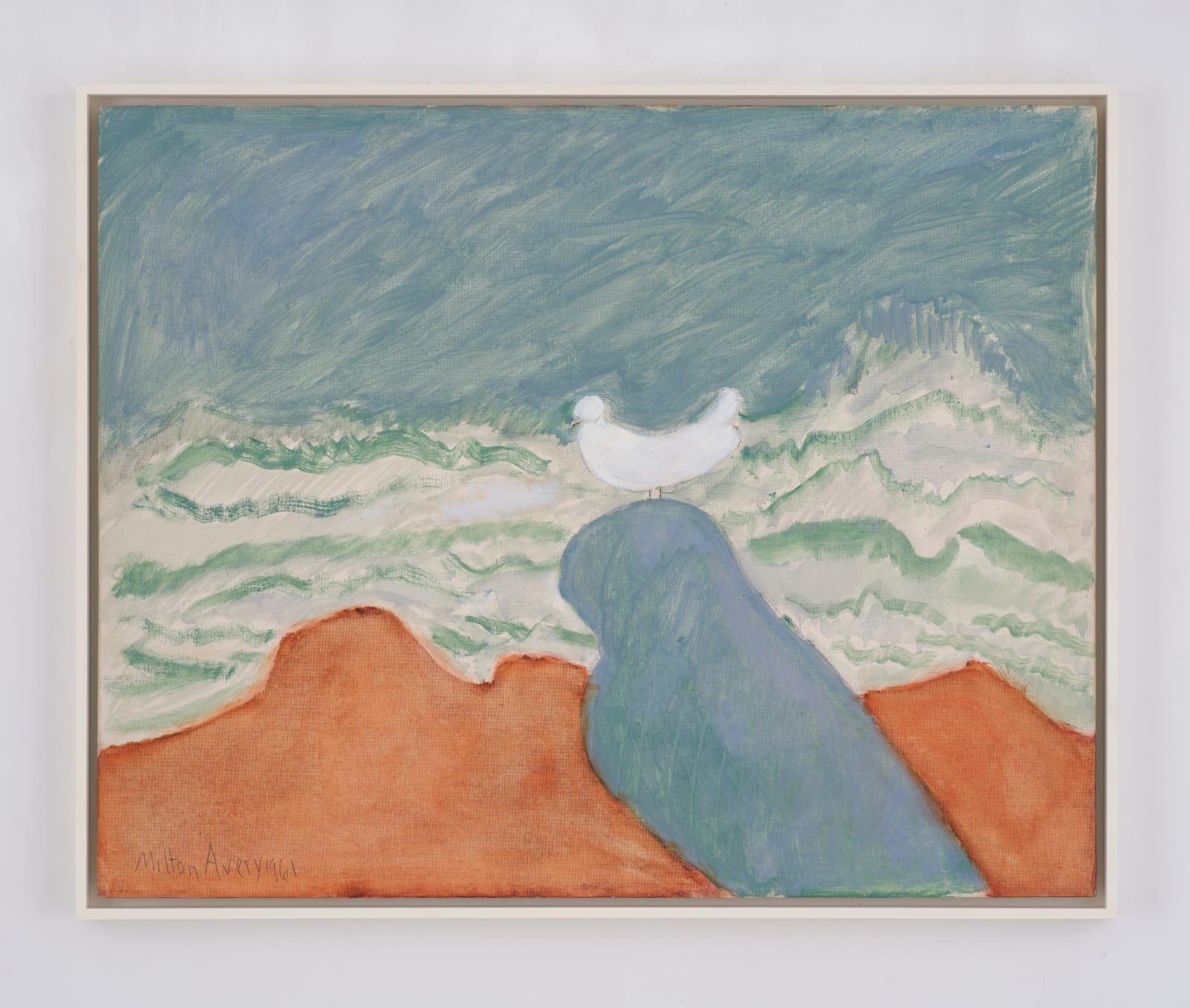
Milton Avery American , 1885-1965
Bird by Wild Sea, 1961
Oil on canvas board
56.2 x 71 cm. (22 1/8 x 28 in.)
Copyright The Artist
Further images
Milton Avery’s Bird by Wild Sea (1961) is an example of the artist’s mature style, a harmoniously balanced composition that straddles the line between abstraction and figuration. The shoreline, a...
Milton Avery’s Bird by Wild Sea (1961) is an example of the artist’s mature style, a harmoniously balanced composition that straddles the line between abstraction and figuration. The shoreline, a recurring subject in Avery’s oeuvre, is here reduced to essential, simplified forms. From the 1950s onwards, Avery increasingly stripped away detail to concentrate on formal qualities – line, texture, form, and compositional balance – elements fully realised in this work.
Previously in the collection of British actor Peter O’Toole, who acquired it from Waddington Galleries in the 1960s, Bird by Wild Sea was part of a small but significant group of Avery paintings that passed through Waddington during that decade. These exhibitions played a key role in introducing Avery’s work to UK audiences and securing his position within the broader narrative of post-war art. This particular painting helped to establish his reputation in Britain as a major figure in twentieth-century American painting.
The range of painterly techniques employed here is striking. The sky is rendered with bold, expressive zigzag brushwork, offering a dynamic counterpoint to the beach, depicted as an almost flat, abstracted plane of colour. The curving rock, biomorphic in form, anchors the composition. Choppy waves expose areas of raw canvas, subtly highlighting the materiality of the surface. The titular bird – small, yet symbolically potent – grounds the painting in a vestige of representation, a quiet nod to reality amidst increasing abstraction.
Around this period, Avery began thinning his paints, producing the luminous washes that would prove highly influential on the emergence of Colour Field painting. Often dubbed the ‘American Fauvist’, Avery’s portraits and still lifes resonate strongly with the work of Henri Matisse. The French master’s 1931 retrospective at New York’s Museum of Modern Art left a clear impression on Avery's art.
Mark Rothko, a close friend and admirer, paid tribute to Avery upon his death in 1965, describing the “poetry and light” of his canvases – qualities Rothko found profoundly moving in a cultural climate often preoccupied with aggression and material force. In Bird by Wild Sea, that poetry is palpable: a lyrical, understated canvas that continues to speak across time.
Previously in the collection of British actor Peter O’Toole, who acquired it from Waddington Galleries in the 1960s, Bird by Wild Sea was part of a small but significant group of Avery paintings that passed through Waddington during that decade. These exhibitions played a key role in introducing Avery’s work to UK audiences and securing his position within the broader narrative of post-war art. This particular painting helped to establish his reputation in Britain as a major figure in twentieth-century American painting.
The range of painterly techniques employed here is striking. The sky is rendered with bold, expressive zigzag brushwork, offering a dynamic counterpoint to the beach, depicted as an almost flat, abstracted plane of colour. The curving rock, biomorphic in form, anchors the composition. Choppy waves expose areas of raw canvas, subtly highlighting the materiality of the surface. The titular bird – small, yet symbolically potent – grounds the painting in a vestige of representation, a quiet nod to reality amidst increasing abstraction.
Around this period, Avery began thinning his paints, producing the luminous washes that would prove highly influential on the emergence of Colour Field painting. Often dubbed the ‘American Fauvist’, Avery’s portraits and still lifes resonate strongly with the work of Henri Matisse. The French master’s 1931 retrospective at New York’s Museum of Modern Art left a clear impression on Avery's art.
Mark Rothko, a close friend and admirer, paid tribute to Avery upon his death in 1965, describing the “poetry and light” of his canvases – qualities Rothko found profoundly moving in a cultural climate often preoccupied with aggression and material force. In Bird by Wild Sea, that poetry is palpable: a lyrical, understated canvas that continues to speak across time.
